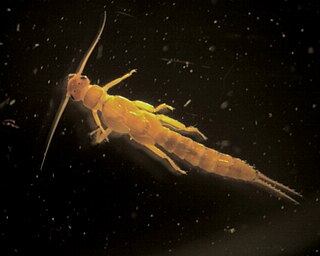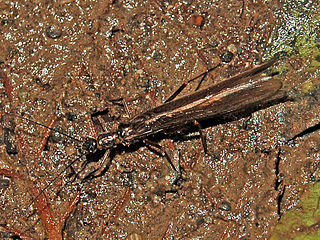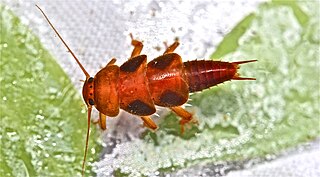
Plecoptera is an order of insects, commonly known as stoneflies. Some 3,500 species are described worldwide, with new species still being discovered. Stoneflies are found worldwide, except Antarctica. Stoneflies are believed to be one of the most primitive groups of Neoptera, with close relatives identified from the Carboniferous and Lower Permian geological periods, while true stoneflies are known from fossils only a bit younger. Their modern diversity, however, apparently is of Mesozoic origin.

The caddisflies, or order Trichoptera, are a group of insects with aquatic larvae and terrestrial adults. There are approximately 14,500 described species, most of which can be divided into the suborders Integripalpia and Annulipalpia on the basis of the adult mouthparts. Integripalpian larvae construct a portable casing to protect themselves as they move around looking for food, while annulipalpian larvae make themselves a fixed retreat in which they remain, waiting for food to come to them. The affinities of the small third suborder Spicipalpia are unclear, and molecular analysis suggests it may not be monophyletic. Also called sedge-flies or rail-flies, the adults are small moth-like insects with two pairs of hairy membranous wings. They are closely related to the Lepidoptera which have scales on their wings; the two orders together form the superorder Amphiesmenoptera.

The Perlodidae, also known as the perlodid stoneflies, stripetails, or springflies, are a family of stoneflies.

The Pteronarcyidae, also known as giant stoneflies or salmonflies, are a family of the order Plecoptera.

The Perlidae are a family of stoneflies, with more than 50 genera and 1,100 described species. The majority of the Perlidae are found in eastern North America, but they occur worldwide except for Antarctica and parts of Africa. Their lifecycles range between one and three years. The adults emerge in the summer; they are very active and known to be attracted to light sources. They are usually very sensitive to changes in environment.

Ephemerellidae are known as the spiny crawler mayflies. They are a family of the order Ephemeroptera. There are eight genera consisting of a total 90 species. They are distributed throughout North America as well as the UK. Their habitat is lotic-erosional, they are found in all sizes of flowing streams on different types of substrates where there is reduced flow. They are even found on the shores of lakes and beaches where there is wave action present. They move by swimming and clinging, they are very well camouflaged. Most species have one generation per year. They are mostly collector-gatherers.

The Nemouridae are a family of stoneflies containing more than 700 described species, occurring primarily in the Holarctic region. Members of this family are commonly known as spring stoneflies or brown stoneflies. Fly fishermen often refer to these insects as tiny winter blacks.

The Capniidae, the small winter stoneflies, are a family of insects in the stonefly order (Plecoptera). It constitutes one of the largest stonefly families, containing some 300 species distributed throughout the holarctic. Their closest relatives are the rolled-winged stoneflies (Leuctridae).

Chloroperlidae are a family of stoneflies, commonly known as green stoneflies, with more than 200 species and 22 genera. They appear green to yellow in colour, and are popularly used among fisherman as bait for trout fishing. Green stoneflies live in the benthic zone of the cold streams and rivers of five continents and four zoogeographical regions, emerging from the water to live in the riparian zone as adults. They are sensitive to pollutants, making them an indicator species for determining the quality of water bodies. Chloroperlidae are hemimetabolous, having no pupal stage, but instead hatch from eggs as nymphs and mature directly into adults. They are omnivorous, feeding on small organisms and plant particles, and become more carnivorous as they mature. The classification of Chloroperlidae is contested, with some believing that they should be considered as members of different orders, as opposed to the order Plecoptera that they currently belong to.

The Leuctridae are a family of stoneflies. They are known commonly as rolled-winged stoneflies and needleflies. This family contains at least 390 species.

Perlodinae is a subfamily of springflies in the family Perlodidae.

Acroneuriinae is a subfamily of common stoneflies in the family Perlidae. There are about 32 genera and about 520 described species in Acroneuriinae.

Perlodini is a tribe of Palaearctic and Nearctic stoneflies in the family Perlodidae. There are more than 80 described species in Perlodini.
Cultus is a genus of stoneflies in the family Perlodidae. There are about five described species in Cultus.

Diploperlini is a tribe of springflies in the family Perlodidae. There are about 13 genera and more than 30 described species in Diploperlini.
Yoraperla is a genus of roach-like stoneflies in the family Peltoperlidae. There are about eight described species in Yoraperla.
Sierraperla is a genus of roach-like stoneflies in the family Peltoperlidae. There are at least two described species in Sierraperla.
Megarcys is a genus of springflies in the family Perlodidae. There are about 11 described species in Megarcys.

Arcynopterygini is a tribe of springflies in the family Perlodidae. There are about 11 genera and more than 30 described species in Arcynopterygini.

Tallaperla is a genus of roach-like stoneflies in the family Peltoperlidae. There are about seven described species in Tallaperla.















